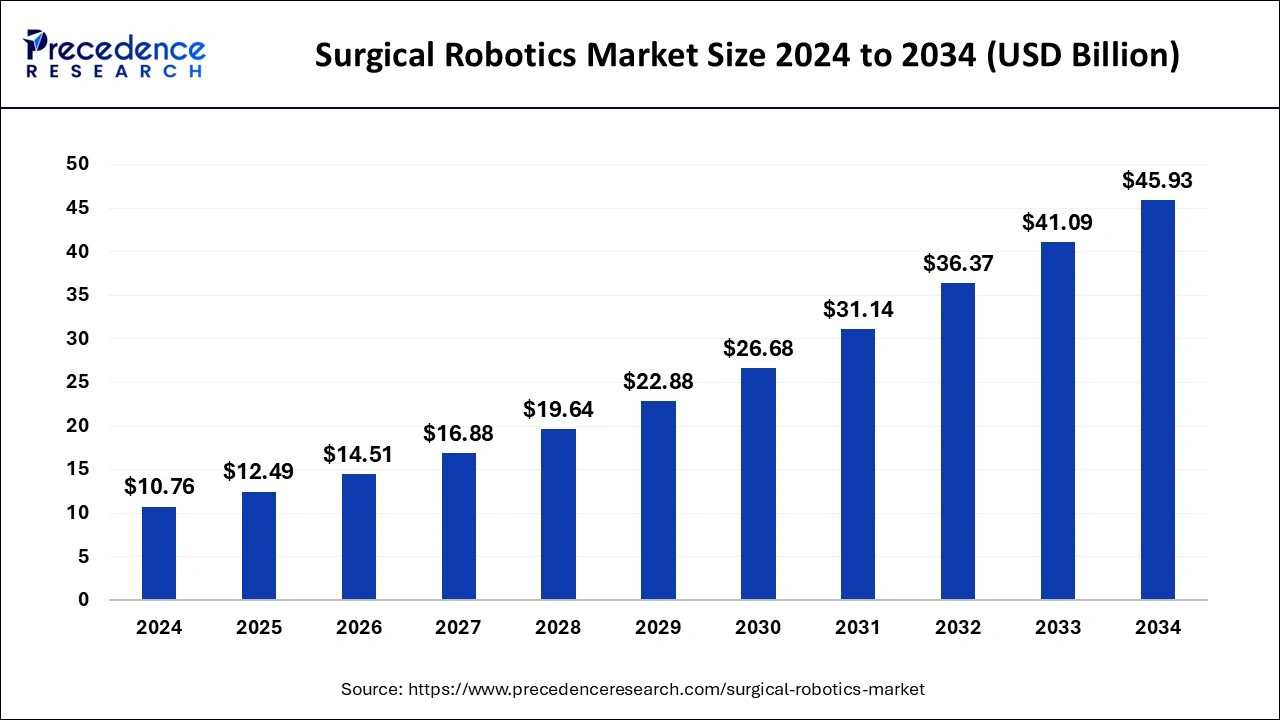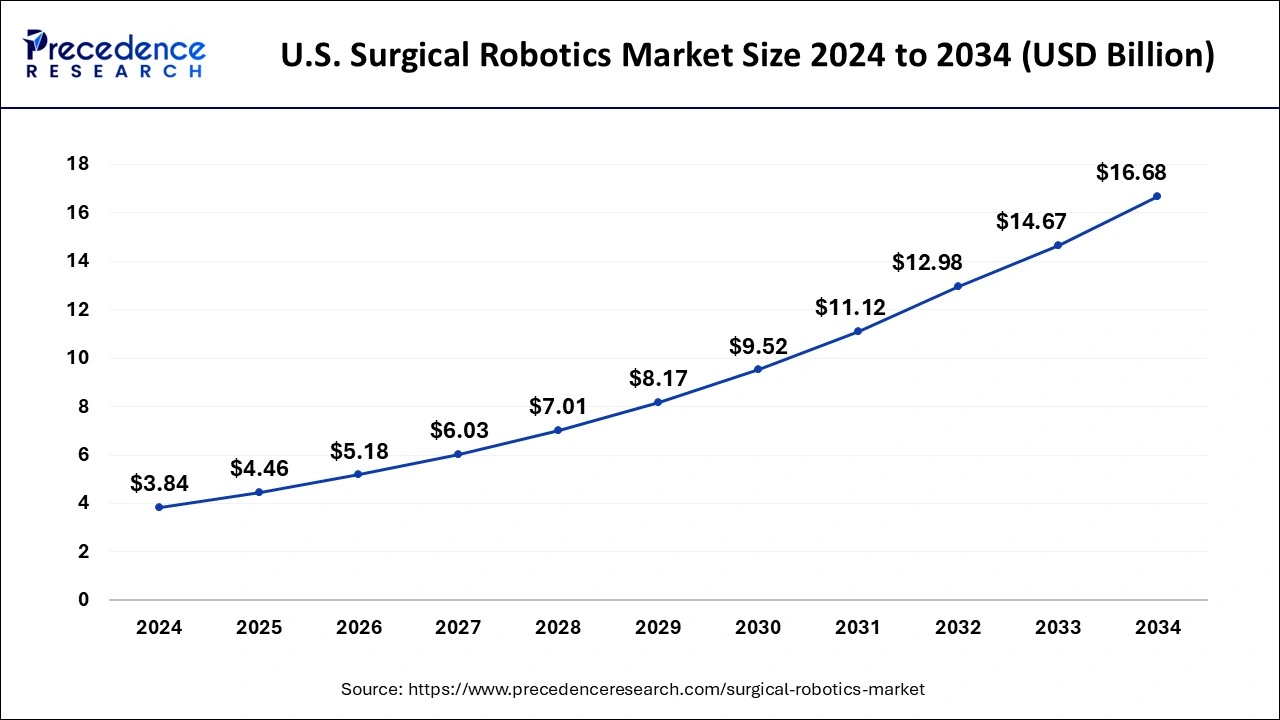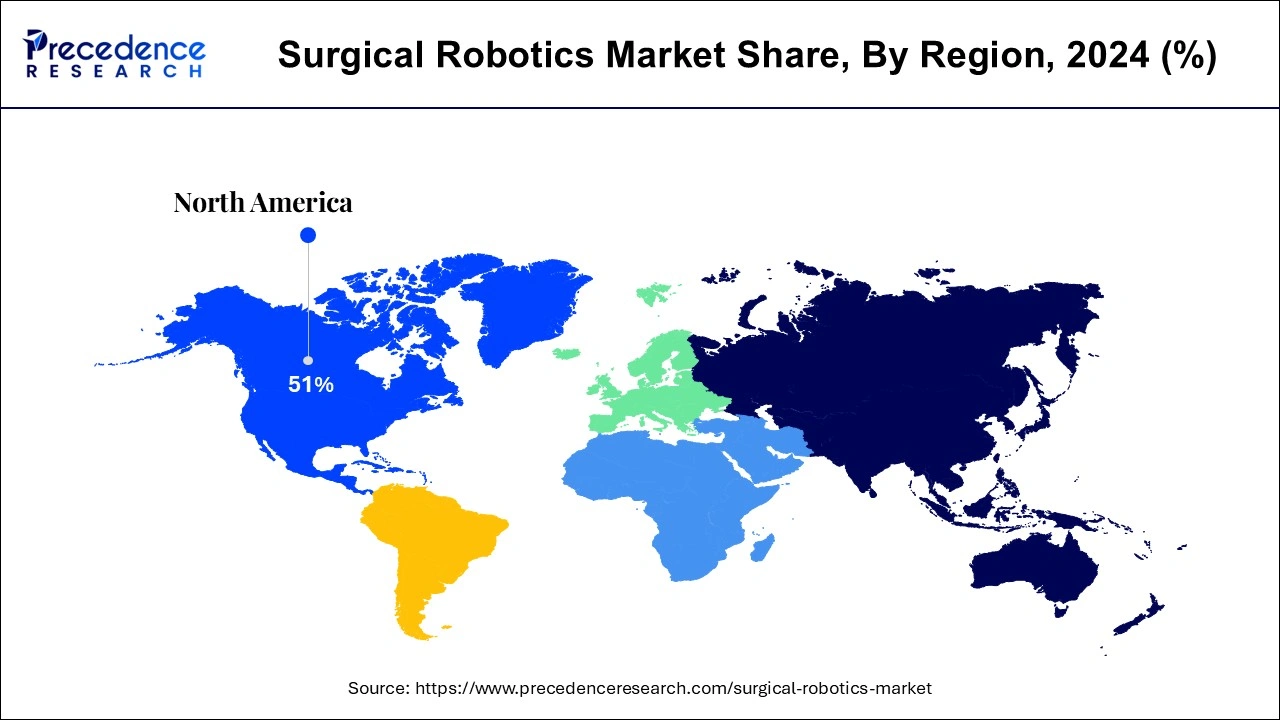September 2024
The global surgical robotics market size is evaluated at USD 12.49 billion in 2025 and is forecasted to hit around USD 45.93 billion by 2034, growing at a CAGR of 15.62% from 2025 to 2034. The North America surgical robotics market size was accounted at USD 5.49 billion in 2024 and is expanding at a CAGR of 15.72% during the forecast period. The market sizing and forecasts are revenue-based (USD Million/Billion), with 2024 as the base year.
The global surgical robotics market size was estimated at USD 10.76 billion in 2024 and is anticipated to reach around USD 45.93 billion by 2034, expanding at a CAGR of 15.62% from 2025 to 2034. The surgical robotics market growth is attributed to the increasing adoption of automated instruments to reduce errors and accelerate surgical procedures.

Artificial intelligence (AI) is revolutionizing various industries, and the healthcare industry is one of them. Integrating AI algorithms in robotic systems enhances accuracy and precision. AI-driven robotic systems automate tasks such as tissue dissection and suturing to reduce surgeon workload and enhance consistency. In addition, AI-driven systems incorporate functionalities such as motion control, image recognition, and haptic feedback, which optimize instrument movements for surgeons and allow an analysis of surgical field images in real-time. AI also helps robotic systems adapt to various tasks, thereby increasing performance. The advantages of AI adoption include improved safety, reduced surgeon fatigue, and enhanced precision. Furthermore, AI integration holds promise for advancing surgical care, with significant advantages such as increased access to specialized expertise and improved patient outcomes.
The U.S. surgical robotics market size was exhibited at USD 3.84 billion in 2024 and is projected to be worth around USD 16.68 billion by 2034, growing at a CAGR of 15.82% from 2025 to 2034.

The North American market had the largest revenue share of about 51% in 2024. The adoption of automated surgical instruments in the health care industry and the increasing health care facilities in the United States will drive the market in this region. The less number of healthcare professionals and surgeons in the US depending upon the patient population will also drive the regional market for surgical robots. Chronic illnesses like diabetes, cancer and the cardiovascular diseases have led to an acceleration growth of the market.

Growing population and increasing adoption of advanced automated surgical devices in the Asia Pacific region will help in the growth of the market. The adoption of advanced medical technology and avalability of modern health care infrastructure has led to a growth in the Asia Pacific region. Investors are investing in automated instruments and this is expected to help in the growth of the market. Growing awareness of robotics in surgery and the higher acceptance rate of the surgical robots in this region, the market is expected to grow.
The in availability of various surgeons and physicians across the globe is leading to an increase in adoption of automated instruments for surgery. The surgeries have evolved. Surgery has now involved the use of robots that are able to do the work with extreme precision compared to the humans. The surgeries with the use of surgical robots are able to provide precision in anatomical areas that are very difficult for human surgeons to perform. Surgical robots are made to solve the limitations in the invasive surgeries and surgical robots are adopted in order to improve the outcome of the open surgical procedures. Surgical robots are used in various areas including cardiovascular, orthopedics, neurosurgery, general surgery, gynecology and obstetrics. The robots used in surgical market are extraordinarily structured in order to have access to various surgeries without making a large incision which normal specialist would do. The medical centers will be able to deliver high quality operations due to the use of robot assisted surgery procedures ever since the product has been introduced in the market that has been a rapid growth.
| Report Coverage | Details |
| Market Size in 2025 | USD 12.49 Billion |
| Market Size by 2034 | USD 45.93 Billion |
| Growth Rate from 2025 to 2035 | CAGR of 15.62% |
| Largest Market | North America |
| Base Year | 2024 |
| Forecast Period | 2025 to 2034 |
| Segments Covered | Component, Surgery Type, End User, and Region |
| Regions Covered | North America, Europe, Asia-Pacific, Latin America and Middle East & Africa |
Growing Preference for Minimally Invasive Surgery
The growing preference for minimally invasive surgical procedures is a key factor boosting the adoption of surgical robotics. Robotic-assisted surgeries are particularly noteworthy as they provide enhanced precision, flexibility, and control in comparison to traditional open surgery methods. These advantages lead to reduced patient recovery times, less postoperative pain, and smaller incisions, improving overall patient outcomes. Continuous advancements in robotics and imaging technologies are playing a crucial role in expanding the capabilities of surgical robots, enabling more complex and delicate procedures to be performed with greater accuracy. As these technologies evolve, they promise to transform surgical practices across various medical specialties.
High Investment
The high initial investment required for acquiring surgical robots can pose a significant challenge to their adoption. The costs associated with purchasing these advanced systems and ongoing maintenance and training expenses can be substantial, particularly for smaller hospitals and clinics that often operate with limited budgets. Furthermore, operating these sophisticated robotic systems necessitates specialized training and expertise, which is not readily available in all healthcare facilities. The lack of a sufficient number of skilled surgeons proficient in the use of robotic technology further limits the widespread acceptance and integration of these innovative surgical solutions into medical practice.
Technological Advancements
There are substantial opportunities for growth within the field of surgical robotics. The development of new applications tailored for various medical specialties, such as neurology, orthopedics, and gynecology, presents promising avenues for expansion and innovation. Additionally, advancements in technology have the potential to enhance the functional capabilities of surgical robots significantly. These advancements could facilitate tasks such as real-time image analysis and personalized treatment planning, making surgeries safer and more effective while allowing for tailored approaches that meet the unique needs of individual patients.
On the basis of the surgery the surgical robotics market is bifurcated into urology surgery, gynecology surgery, neurosurgery, general surgery, orthopedic surgery and other surgeries. The Neurosurgery segment is expected to grow at the fastest rate during the forecast. There is great amount of adoption of robots in neuro surgeries over the traditional techniques. Technological advancements and the use of robots in neuro Surgeries have successful outcomes. The use of automated robotic instruments in brain surgeries will help in the growth of the market. The orthopedic Surgery segment has the good position in the market as there are many injuries caused due to bike and road accidents or any other accidents that need surgeries. Arthritis, joint pains and other reasons for correcting the bones are expected to help in the growth of the market. There's an increased use of robotics for treatment of cancer. For minimally invasive laparoscopic surgeries the demand for robotics has increased in the recent years.
The component segment is bifurcated into systems, accessories and services. The accessory segment has dominated the global surgical robotics market due to an extensive use of accessories for the surgical procedures. The Services segment is also expected to grow well due to a rise in the robot assisted surgeries across the nations. Increase in the geriatric populationand chronic diseases like diabetes, arthritis and HIV AIDS leads to the growing use of robots.
On the basis of the end user, the surgical robotics market is expected to grow in the hospital segment. In the coming years, there shall be an increase in the demand for surgical reports at various hospitals settings and it will offer a lucrative market growth. Surgical robots at the hospital settings will be able to help with effective patient care. The high amount of inpatient visits and increasing surgical procedures at the hospital will lead to the growth in the market. Larger and better hospital infrastructure along with the skilled healthcare personnel available at this infrastructure will help in changing the scenario in various emerging economies.
By Component
By Surgery Type
By End User
By Geography
For inquiries regarding discounts, bulk purchases, or customization requests, please contact us at sales@precedenceresearch.com
No cookie-cutter, only authentic analysis – take the 1st step to become a Precedence Research client
September 2024
September 2024
January 2025
January 2025